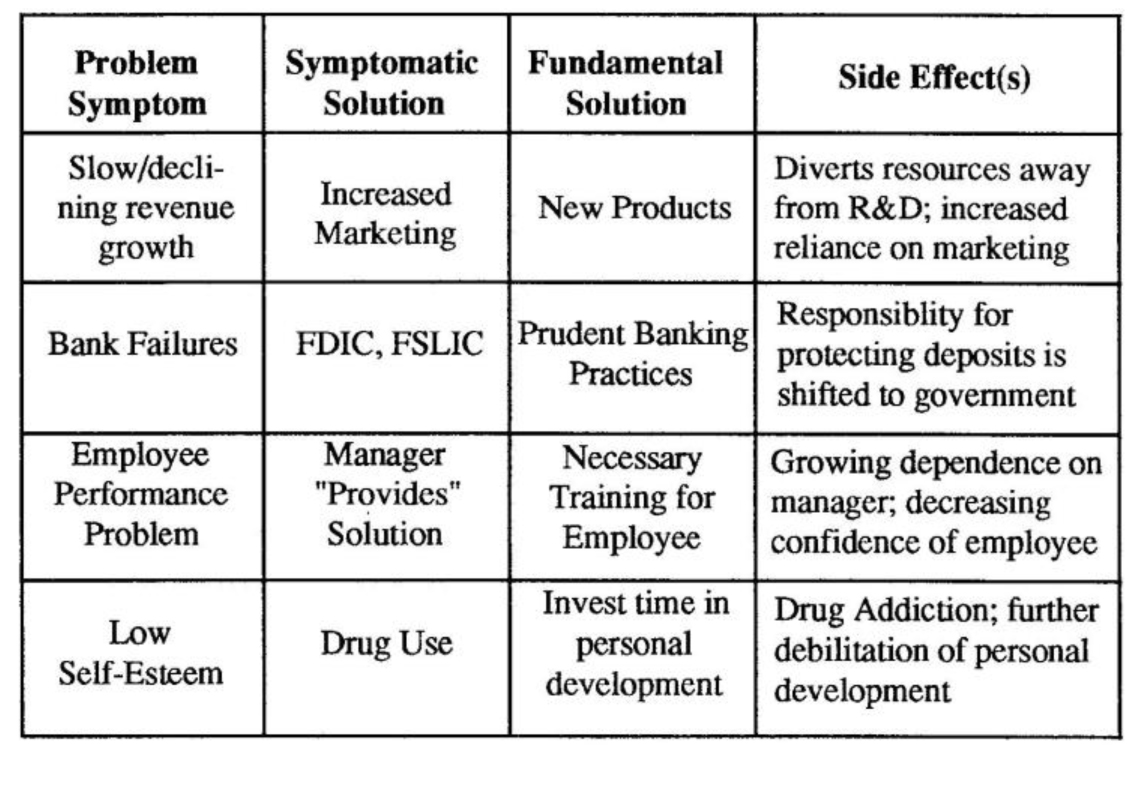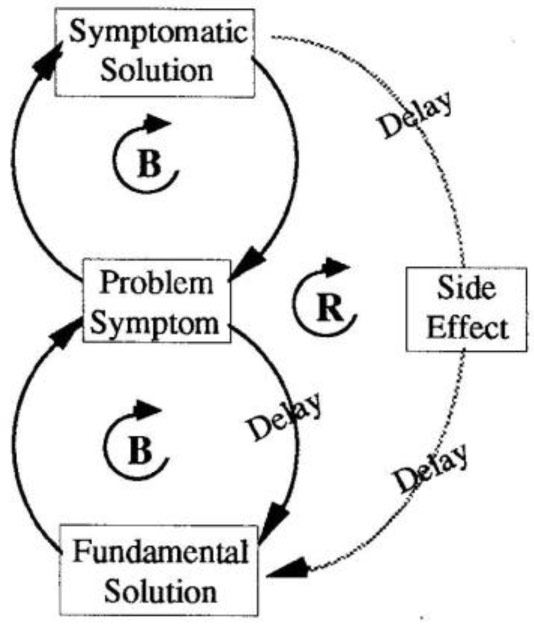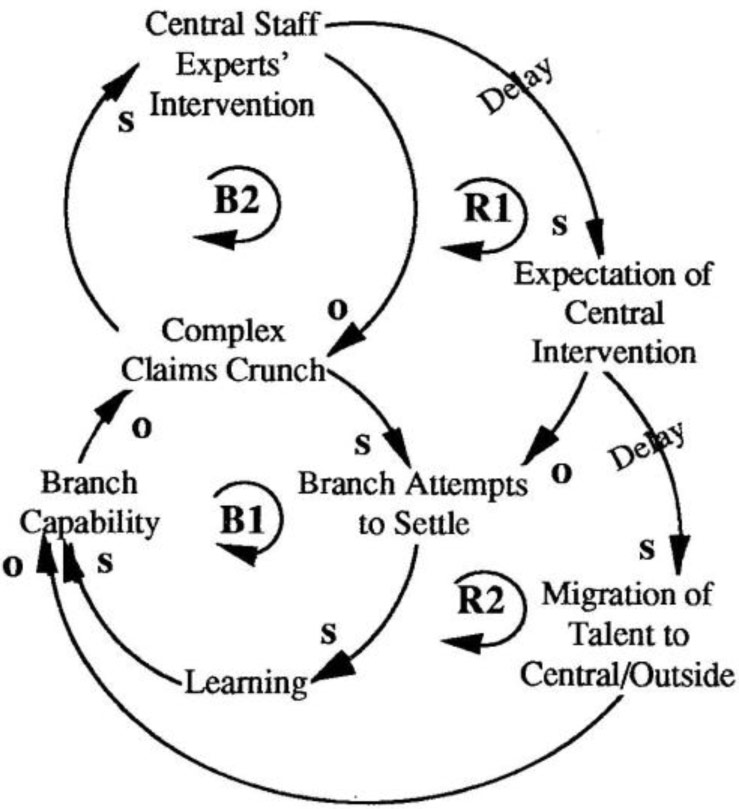Most of us know the story of Helen Keller and have probably sympathized with her and her parents, whose actions to protect their handicapped daughter seemed not only compassionate but necessary. After all, how could a blind and deaf child ever be expected to take care of herself? But if it had not been for the determined efforts of her teacher, Ann Sullivan, who refused to let Helen’s handicaps prevent her from becoming self-reliant, Helen probably never would have achieved her real potential. She went on to graduate from Radcliffe College and become an author as well as spokesperson and role model for many of the nation’s handicapped.
Shifting the Burden Examples

Helen Keller’s story is much more than an inspirational human interest story; it illustrates a pervasive dynamic that is rooted in an archetypal structure. The well-intentioned actions of her parents shifted the burden of responsibility for Helen’s welfare to them. Every problem or failure on Helen’s part brought the parents rushing to her aid. Helen learned that no matter what she did, her parents would accommodate her. And each incident reinforced her parents’ belief that she was indeed helpless. All three were caught in a system that was eroding Helen’s ability (and desire) to cope with the world and shifting the responsibility for her well-being to her parents.
The Structure
The basic structure of this archetype is shown in the diagram labeled “Shifting the Burden Template.” The archetype usually begins with a problem symptom that prompts someone to intervene and “solve” it. The solution (or solutions) that are obvious and immediately implementable usually relieve the problem symptom very quickly. But these symptomatic solutions have two specific negative effects. First, they divert attention away from the real or fundamental source of the problem. More subtly, symptomatic solutions cause the viability of the fundamental solution to deteriorate over time, reinforcing the perceived need for more of the symptomatic solution.
Shifting The Burden Template

In the Helen Keller story, her parents’ intervention is the symptomatic solution, Helen’s failure to cope with real world is the problem symptom, the development of Helen’s own abilities to care for herself is the fundamental solution, and the side effect is that her parents assume increasing responsibility for her well-being. This particular type of shifting the burden structure, in which responsibility is shifted to a third party, is known as “Shifting the Burden to the Intervener.” Over time, the role of the intervener increases, until it becomes an essential part of the system. In Helen’s case, her parents’ actions reinforced the underdevelopment of her abilities and therefore strengthened their role as “protectors.”
Another very common side effect that occurs in “Shifting the Burden” situations is that the person may become “addicted” to the symptomatic solution. For example, a person who turns to alcohol or drugs to boost his self-esteem or help deal with stress may end up developing an alcohol or drug dependency.
Central vs. Local
Central Support vs. Branch Capability

The “Shifting the Burden” archetype and its variants — “Addiction” and “Shifting the Burden to the Intervener” — comprise perhaps the single most pervasive systems structure. The diagram labeled “Central Support vs. Branch Capability” illustrates a classic example of this dynamic.
A claims office in a local branch of a large insurance company is faced with a large, complex claim that requires more expertise than it possesses. The central office responds by sending out its corps of experts who take care of the complex claim while the branch office goes about its other, more routine business. Although the occurrence of large claims may be infrequent — making it hard to justify keeping such experts in every branch — over time the interventions can result in deteriorating branch capability.
The reason is that after a while, an implicit operating norm develops that says if a person wants to handle complex, technically challenging claims she has to either join the central office or move to a different firm. Gradually, the most talented people take either of the two options. Unless these people can be replaced by equally capable adjusters, the talent of the branch office gradually erodes, making it rely even more on central support. The cycle is reinforcing — as the central staff becomes better at intervening, the branch seeks their help more often.
Using the Archetype
Templates — causal loop diagrams that trace out generic dynamic structures — serve as a useful guide for mapping out archetypes. The basic “Shifting the Burden” Template serves as a starting point, but templates are not meant to be rigid structures in which we must “fit” a specific case. Tracing out the fundamental solution in the Central vs. Local situation, for example, requires more than a single variable — “Branch attempts to settle claims,” “Learning,” and “Branch ability” are all part of the fundamental solution.
In theory, any one of the four elements of the template — problem symptom, symptomatic solution, side effect, and fundamental solution — can help us identify a “Shifting the Burden” structure at work. Side effects, however, are usually very subtle and difficult to detect from inside the system. Solutions such as alcohol use, increased marketing, oil imports, or federal insurance are more readily identified, but there may not be complete agreement on whether they are “symptomatic” or “fundamental.” Identifying problem symptoms such as high stress, falling revenues, energy shortage, or bank failures (see “Table of Shifting the Burden Examples”) is probably the easiest way to begin filling out a “Shifting the Burden” template.
Keeping in mind that the “rightness” of a solution depends on one’s perspective, it can be helpful to ask whether we are seeing the situation from the parents’, Helen Keller’s, or Ann Sullivan’s point of view. Examining a problem or issue from these different viewpoints can help us understand why a “Shifting the Burden” archetype is operating and discover a solution that is fundamental, not symptomatic.
